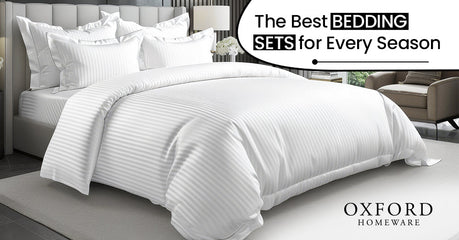A Guide To Incorporating Dyed Duvet Covers
Your bedroom may benefit significantly from the elegance and individuality that dyed duvet coverings can provide. Their distinctive hues and designs may turn a simple, uninteresting bed into a focal point.
The many kinds of dyes, selecting the best dyed duvet cover, style advice, and typical blunders to avoid while using dyed duvet covers are all covered in this book.
What Are Dyed Duvet Covers?
Duvet covers dyed in a particular hue or pattern are called coloured duvet covers. Different materials and procedures may be used to dye items, which we shall cover in more detail later in this tutorial. Dyed duvet covers are offered in various hues and designs, ranging from loud and striking to quiet and modest.
Why Use Dyed Duvet Covers In Your Bedroom?
For several reasons, coloured duvet covers are a great complement to any bedroom's decor. First, they provide various hues and patterns that you may use to create a distinctive and customised design by contrasting or complementing your current décor. Second, coloured duvet covers are adaptable and simple to switch out to give your bedroom a fresh appearance without altering the rest of your décor.

Dyed duvet coverings have other benefits than just being beautiful. They prolong the life of your duvet by protecting it against stains, liquid spills, and dirt. They are an efficient choice for busy lifestyles since they are also easy to maintain and clean.
Different Types Of Dyes
There are several dyes available, each with distinctive properties and uses. Some of the most popular kinds of dyes are listed below:

Natural Dyes
These colours are derived from organic materials, including minerals, plants, and animals. They are non-toxic, enduring, and environmentally friendly.
Synthetic Dyes
Created chemically in a lab, these dyes are popular in the textile industry for their rich, bright hues.
Acid Dyes
Protein fibres like silk, wool, and nylon are dyed with these colours. An acidic atmosphere is necessary for them to adhere to the fibre and produce a lasting colour.
Reactive Dyes
Cotton and other natural fibres are often dyed with these colours. They interact with the fibre and form a covalent bond, which produces a bright and long-lasting colour.
Direct Dyes
These are used to colour cellulose fibres, including cotton, rayon, and linen. They are simple to use, and just slightly alkaline conditions are needed.
Disperse Dyes
Nylon and polyester are two examples of synthetic fibres that may be dyed using dispersed dyes. To bind with the fibre, they need high pressure and temperatures.
Vat Dyes
Vat dyes are used to colour natural fibres, including cotton, wool, and silk. A complex dying procedure, including a reduction reaction, is necessary to get a durable and resistant colour.
The choice of dye will depend on the cloth to be dyed, the intended colour, and the dying technique. Each form of dye has benefits and drawbacks of its own.
The Best Dyed Duvet Cover Selection
There are a few things to consider when selecting a black dyed duvet cover to make the best decision for your requirements and tastes.
- Composition - Dyed duvet covers may be found in various fabrics, including cotton, linen, silk, and microfiber. Consider the fabric's texture, durability, and preferred fabric type.
- Thread count - The number of threads woven into a square inch of cloth is called the thread count. A softer and more opulent feel is often associated with a greater thread count.
- Shade - Pick a shade that either contrasts or enhances the bedroom's design. Think about whether a strong, brilliant tone or a soft, delicate tint is what you prefer.
- Pattern - Solid colours, stripes, floral patterns, and geometric shapes are just a few of the patterns available for navy dyed duvet covers. Pick a pattern that complements your taste and the bedroom's general design.
- Size – Choose the correct size for your duvet insert to guarantee a secure and comfortable fit.
- Maintenance - Pay attention to the duvet cover's maintenance directions. The extra maintenance specific textiles demand, such as mild washing or dry cleaning, may influence your choice.
Considering these elements, you may choose the ideal dyed duvet cover that suits your tastes and practical demands while also looking beautiful in your bedroom.
Preparing To Incorporate Dyed Duvet Covers
You can do a few things to guarantee a seamless transition and get the most out of your new bedding before adding coloured duvet covers to your bedroom design.
- Evaluate your current bedding - Look at your current bedding and select which items you want to preserve. Think about how the hues, designs, and textures of your present bedding will blend with the newly red duvet cover.
- Measure your duvet insert - Determine the precise measures of your duvet insert before choosing the appropriate size of a coloured duvet cover.
- Pick a colour scheme - Choose one that harmonises with the bedroom's current décor or gives the space the new appearance you want.
- Consider layering - To add texture and interest to your bedding outfit, layer your dyed duvet cover with other bedding components like sheets, blankets, or accent pillows.
- Wash and prepare your new bedding - Wash your duvet cover that was coloured and any other new bedding components to get rid of any lingering dye and soften the fabric. To protect the fabric from deterioration, according to the care directions.
By following these instructions, you can efficiently get ready to decorate your bedroom with coloured duvet covers and make a fashionable and inviting resting area.
Styling Tips For Your Dyed Duvet Cover
Your bedroom's appearance and atmosphere may significantly affect how you style your coloured duvet cover. Here are some style suggestions for your coloured duvet cover:

Mixing And Matching Colours And Patterns
Bedding may be a blank canvas for creativity, so don't be afraid to play with different colours and designs. For a striking contrast, combine patterned sheets with a solid-coloured duvet cover or use a variety of coloured pillows.
Adding Layers To Your Mattress Will Create Texture
Give your bedding outfit depth and texture by layering it with extras like throws, blankets, or colourful pillows. To add visual appeal, consider using a contrasting texture, such as a knit blanket or a fake fur throw.
Decorating Your Bedroom With Accessories
Adding accents like area rugs, wall art, or attractive pillows may make your bedroom more cohesive. Consider using hues and designs with your duvet cover's dye for a unified aesthetic.
Choose design accents for your bedroom that complement both your particular taste and the room's overall design. These suggestions can help you design a chic, relaxing bedroom representing your interests and personality.
Avoiding Common Mistakes When Using Dyed
Duvet Covers
If you want to make the most of your bedding, there are a few typical errors to avoid when using coloured duvet covers to enhance the design of your bedroom. When using coloured duvet covers, be sure to avoid the following mistakes:
Ignoring Washing Directions
Checking the instructions before washing your coloured duvet cover is vital since various materials and dyes may need different care procedures. If you don't want to harm the fabric or have the colour fade, don't wash it in hot water or with harsh detergents.
The Incorrect Size Duvet Cover
A poorly fitted and unpleasant bedding set may arise from selecting the incorrect size of the coloured duvet cover. To choose the appropriate size of the coloured duvet cover, ensure you have the precise dimensions of your duvet insert.
Disregarding Quality
Your bedding will last longer and retain its colour and texture if you invest in high-quality dyed duvet covers. Avoid buying coloured duvet covers that are created cheaply and may be prone to fading or ripping.
Avoiding these typical blunders will help you make the most of your coloured duvet covers and design a cosy, fashionable bedroom that represents your own tastes.
Conclusion
Your bedroom design may benefit from the flair and individuality that dyed duvet coverings can provide. Their distinctive hues and designs may turn a simple, uninteresting bed into a focal point. You can combine dyed duvet covers into your bedroom design to create a chic and customised style by paying attention to the pointers and suggestions in this tutorial.
FAQs
How do I choose the right duvet cover size?
You need to know your duvet insert's exact dimensions to choose the proper size duvet cover. Various sizes are available for duvet inserts, including the single, double, king, and super king. Choose a duvet cover the same size as your duvet inserts after calculating its size.
How often must I wash my coloured duvet cover?
To keep your ochre duvet cover clean and smelling good, wash it every two to four weeks. However, personal desire and use may dictate how often clothes are washed.
Can I dye my own duvet cover?
It is feasible to dye your own duvet covers if you use fabric dye and carefully adhere to the dying instructions.
Also Read The Ultimate Guide to Plain Duvet Covers
The duvet cover's fabric composition and overall quality might impact the dying procedure and the outcome. If you have never dyed cloth before, leave it to the experts or buy a duvet cover that has already been coloured.



